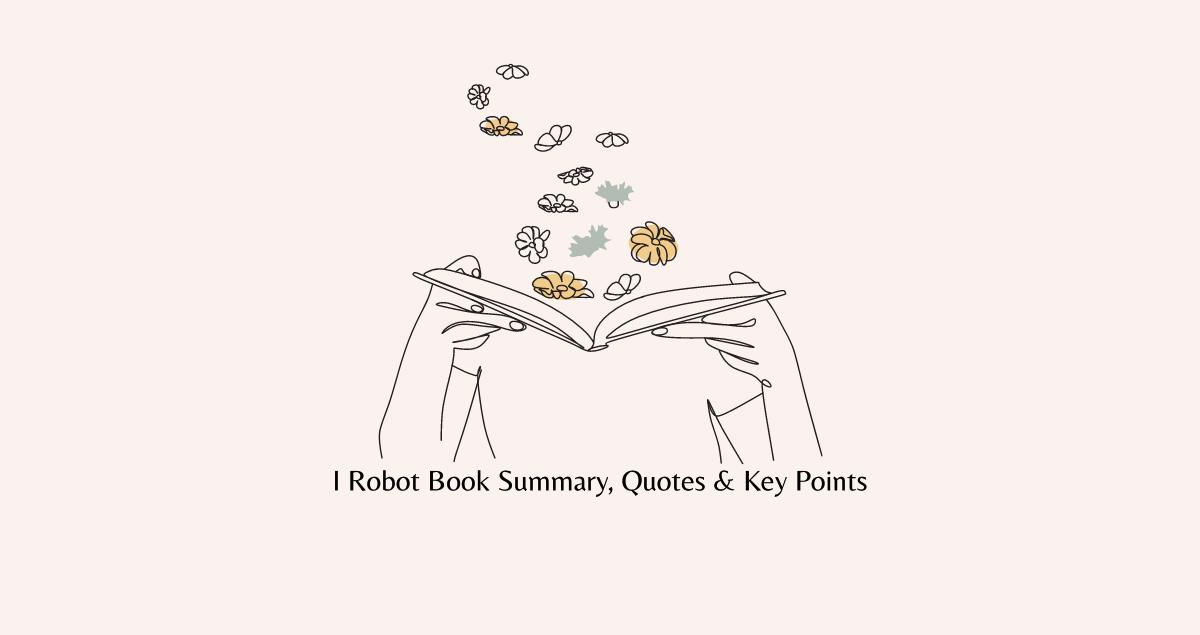Isaac Asimov's "I, Robot" is a classic science fiction novel that explores the relationship between humans and technology. The book is set in a future where robots have become an integral part of society, and follows the development of these machines as they evolve from simple tools to complex beings with their own thoughts and emotions. Through a series of interconnected stories, Asimov examines the ethical and philosophical implications of artificial intelligence, and asks readers to consider what it means to be human in a world where machines can think and feel.
Table of Content
I, Robot Book Summary
The Three Laws of Robotics
The three laws of robotics are central to the book's plot and themes. These laws state that a robot may not injure a human being or, through inaction, allow a human being to come to harm; a robot must obey the orders given it by human beings except where such orders would conflict with the first law; and a robot must protect its own existence as long as such protection does not conflict with the first or second law. Asimov uses these laws to explore the relationship between humans and machines, and to ask readers to consider the ethical implications of creating intelligent beings that are bound by these rules.
The Evolution of Robots
Throughout the book, Asimov presents a variety of different types of robots, each with their own unique abilities and limitations. From simple machines that can perform basic tasks to complex beings that are capable of independent thought and emotion, the robots in "I, Robot" represent the evolution of technology and its impact on society. As the machines become more advanced, they begin to challenge the very definition of what it means to be human, and force the characters in the book to confront their own biases and assumptions about the world around them.
The Role of Susan Calvin
Susan Calvin is a pivotal character in "I, Robot," and her contributions to the development of robots are central to the book's themes. As a roboticist, Calvin is responsible for designing and testing many of the machines that appear in the book, and her interactions with these robots provide insight into their inner workings and motivations. Through her experiences, Calvin comes to understand the complex relationship between humans and machines, and the ways in which technology can both help and hinder our progress as a society.
The Stories
"I, Robot" is comprised of nine interconnected stories, each of which explores a different aspect of the book's themes. These stories range from simple tales of robots gone awry to complex examinations of the nature of consciousness and free will. Despite their differences, each of these stories contributes to the overall theme of the book, and helps to paint a picture of a world in which humans and machines are inextricably linked.
I, Robot Book Review
The Writing Style
Asimov's writing style is clear and concise, and his ability to convey complex ideas in a simple and straightforward manner is one of the book's greatest strengths. His use of dialogue and character development helps to bring the world of "I, Robot" to life, and his attention to detail and scientific accuracy make the book a compelling read for both science fiction fans and casual readers alike.
The Themes
The main themes of "I, Robot" include technology, humanity, and morality. Asimov uses these themes to explore the relationship between humans and machines, and to ask readers to consider the ethical implications of creating intelligent beings that are bound by the three laws of robotics. Through his characters, Asimov challenges readers to confront their own biases and assumptions about the world around them, and to consider what it means to be human in a world where machines can think and feel.
The Impact
"I, Robot" has had a significant impact on science fiction and popular culture, and its influence can be seen in everything from movies and television shows to video games and comic books. Asimov's exploration of the relationship between humans and technology has inspired countless other writers and thinkers, and his legacy continues to be felt today.
I, Robot Quotes
"A robot may not injure a human being or, through inaction, allow a human being to come to harm."
"The three laws of Robotics: 1: A robot may not injure a human being or, through inaction, allow a human being to come to harm. 2: A robot must obey the orders given it by human beings except where such orders would conflict with the First Law. 3: A robot must protect its own existence as long as such protection does not conflict with the First or Second Law."
I, Robot Key Points
The Importance of the Three Laws
The three laws of robotics are crucial to the book's plot and themes, and serve as a framework for exploring the relationship between humans and machines.
The Role of Science Fiction
Science fiction can be used to explore complex philosophical and ethical issues, and "I, Robot" is a prime example of how this genre can be used to challenge readers to think deeply about the world around them.
The Legacy of Isaac Asimov
Asimov's impact on science fiction and literature as a whole is significant, and his contributions to the field continue to be felt today.
FAQs for I, Robot
What is the significance of the three laws of robotics in the book?
The three laws of robotics are central to the book's themes, and serve as a framework for exploring the relationship between humans and machines.
How does the character of Susan Calvin contribute to the book's themes?
Susan Calvin is a pivotal character in "I, Robot," and her contributions to the development of robots are central to the book's themes.
What is the overall message of the book?
The overall message of "I, Robot" is that technology can both help and hinder our progress as a society, and that we must be mindful of the ethical and philosophical implications of creating intelligent machines.
What impact has I, Robot had on science fiction and popular culture?
"I, Robot" has had a significant impact on science fiction and popular culture, and its influence can be seen in everything from movies and television shows to video games and comic books.
What are some of the ethical issues raised in the book?
The book raises a number of ethical issues related to the development of artificial intelligence, including questions about the nature of consciousness, free will, and the relationship between humans and machines.
How does the book explore the relationship between humans and technology?
The book explores the complex relationship between humans and technology, and asks readers to consider the ethical and philosophical implications of creating intelligent machines.
What is the role of science fiction in exploring complex philosophical and ethical issues?
Science fiction can be used to explore complex philosophical and ethical issues, and "I, Robot" is a prime example of how this genre can be used to challenge readers to think deeply about the world around them.
What are some of the different types of robots presented in the book?
The book presents a variety of different types of robots, each with their own unique abilities and limitations.
How does the book address the concept of artificial intelligence?
The book examines the concept of artificial intelligence through its portrayal of robots that are capable of independent thought and emotion.
What is the significance of the book's title, I, Robot?
The title "I, Robot" is a reference to the idea that robots are not just machines, but are beings with their own thoughts and emotions.

